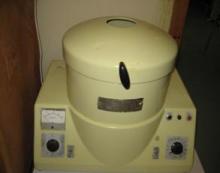The basic design of a centrifuge consists of a rotor which holds samples and rotates around a fixed axis driven by a motor. More advanced centrifuges may also have lubrication and cooling systems. In addition to this, some centrifuges are capable of creating a vacuum environment around the rotor.
Depending on the sample/ rotor size and speed of centrifugation different types of centrifuge tubes can be used. Proper selection of centrifuge tubes helps to ensure that leakage does not occur and none of the sample is lost, the chemical properties of the sample and the tube do not conflict, and that the sample can be recovered with little effort.
There are two basic types of preparative centrifuges: superspeed centrifuges and ultraspeed centrifuges or ultracentrifuges. Superspeed centrifuges generally operate at speeds up to about 20,000 rpm. These centrifuges usually do not require evacuation of the rotor chamber, and drive the rotor directly to through belts or gears.

